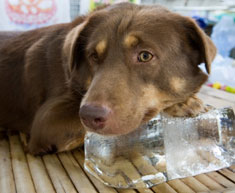
The best treatment for an overheated dog is prevention. Photo: iStock
Ask The Professor
How can I tell if my dog is overheating, and what can I do about it?
Scott Shaw, V98, assistant professor of clinical sciences and a specialist in emergency and critical care medicine at the Cummings School, responds:
Heatstroke in dogs is a life-threatening situation. It is more common on humid days, particularly early in the summer when your dog hasn’t had time to adjust to the warm weather. Older dogs as well as the brachycephalic breeds—dogs with short noses such as pugs and bulldogs—are predisposed to developing heatstroke. When your dog’s body temperature rises too high, numerous organs can be damaged, including the heart, liver, kidneys and brain.
The earliest sign of heatstroke is excessive panting with excessive salivation. As the condition gets worse, a dog’s gums will turn dry and dark pink, and the animal will become weak and may have trouble standing. At its most severe, dogs with heatstroke can develop seizures and severe bloody diarrhea.
The best treatment is prevention. Make sure your dog always has access to plenty of fresh water. Avoid exercise during the hottest part of the day. If you are concerned your dog is becoming overheated, you should cool him down as quickly as possible with cool, not cold, water. If your dog becomes weak or collapses, rapid cooling is the most important thing you can do before getting your dog to the vet.
Have a question for “Ask the Professor”? E-mail taylor.mcneil@tufts.edu.


